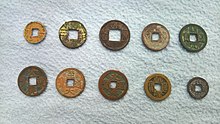User:Donald Trung

|

|

|

|

|

|

| |||
User 
|
Talk 
|
Chinese cash coins 
|
French Indo-Chinese banknotes 
|
Chinese charms, amulets, and talismans 
|
Nguyễn Dynasty documents 
|
Numismatic books 
|
Weird stuff 
|
Articles 
|
Links 
|


 .
.| This user contributes to Wikimedia Commons. |
 | This user is interested in the politics of the Vietnam War. |
| To document, not to serve. | |
|---|---|
| I am mostly active on Wikimedia Commons, but will occasionally check back here and will expand articles or create new ones if I discover new sources. But if I'm inactive for a long period of time it mostly means that I haven't found any sources to import information 🛈 from. | |
Quotes
Chữ Nôm quote
「伴空體讀得𡨸喃除欺伴別𡨸漢」拱𠽋唭如「伴空體曉『縺』『烏穌』『咖啡』除欺伴別吶㗂法」。
"You are not able to read Chữ Nôm unless you can understand Chữ Hán" is as ridiculous as "You cannot understand 'len', 'ô tô' or 'cà phê' unless you are able to speak French".
A joke about a Confucian scholar
There is a Confucian scholar from the countryside, who only recently decided to learn Latin script. Being proud of being such an innovative thinker, he went to the provincial capital to see if they have a job for him. Suddenly he felt the urge to urinate, but he doesn't know what to do. He then happened to see a wall surrounding a clean whitewashed office, on the wall he can clearly see 4 (four) words written on them in Latin script. The Confucian scholar felt so relieved that he immediately pulled his trousers down and started peeing at the bottom of the wall. Suddenly a policeman (Người cảnh binh) came to arrest him. The Confucian scholar said: "Why punish me? I clearly read the four (4) words "Đái được không cấm" (Urinating is not forbidden)." The policeman then replied with "You're wrong. Latin script is read from left-to-right. It is not read like Chinese characters which are written right-to-left. These four (4) words are read "Cấm không được đái" (It is forbidden to urinate)!".
(Có thày đồ nho ở quê, mới học được chữ Quốc ngữ, tự hãnh diện là mình tư duy đổi mới. Thày ra tỉnh có việc. Gặp lúc thày mót tiểu tiện, loay hoay không biết làm sao. Tình cờ thấy có bức tường bao quanh một công sở quét vôi sạch sẽ, trên đề bốn chữ Quốc ngữ. Thày mừng quá, vạch quần ra đái ngay dưới chân tường. Có người cảnh binh đến bắt phạt. Thày bảo : « Sao lại phạt ? Tôi đọc rõ ràng bốn chữ « đái được không cấm ». Người cảnh binh trả lời: « Ông nhầm rồi. Chữ quốc ngữ đọc từ trái sang phải. Không phải là chữ Nho, mà đọc từ phải sang trái. Bốn chữ này là “cấm không được đái” đấy!».).
My interest in heraldry

My interest in heraldry is similar in source as my interest in coins and these are in fact very much intertwined and are parts of my interest in symbols and symbology in general. Most coins display various forms of national and nationalist symbols on them and are often the easiest and cheapest ways to own an image of a coat of arms or a national emblem. Coins often tell a story and so do various forms of heraldry, sometimes these stories are very deep, at other times they appear somewhat shallow, but what might initially appear to be a very "shallow" symbol will often have a very long and complicated history behind it. Wikipedia has always been a very handy source to find this information, in fact, I'd argue that it is the best website for learning about the history of various symbols and coats of arms. Despite my interest in flags and coats of arms as well as other heraldry I don't commonly write about these topics, mostly because I don't really have access to the sources I personally prefer to use and the articles I did write about these topics are always based on sources I believe are trustworthy. While, without much reservation, I'd say that Wikipedia is the best website to find information about heraldry about and I don't think that there is any website that has more images of heraldry than the Wikimedia Commons, I still believe that one should employ caution when reading Wikipedia and always consult additional sources.
I can't exactly say when my interest in heraldry started, while I've been interested in collecting money for their beauty my entire life, I can't really remember when I actually became interested in coats of arms and other heraldry, perhaps it was before I found Wikipedia but I don't think so. I used to save as many images of coats of arms and flags from Wikipedia as possible when I was younger and used it to design my own, I think that a lot of people probably had a similar story to me, they discover Wikipedia, discover infoboxes, and get interested in the stuff that is found in infoboxes. Coats of arms and emblems are often quite interesting because while people try to keep the design of flags often as simple as possible, heraldry is more often designed to try to preserve as many historical symbols as possible and represent a location or locality in a detailed way.
